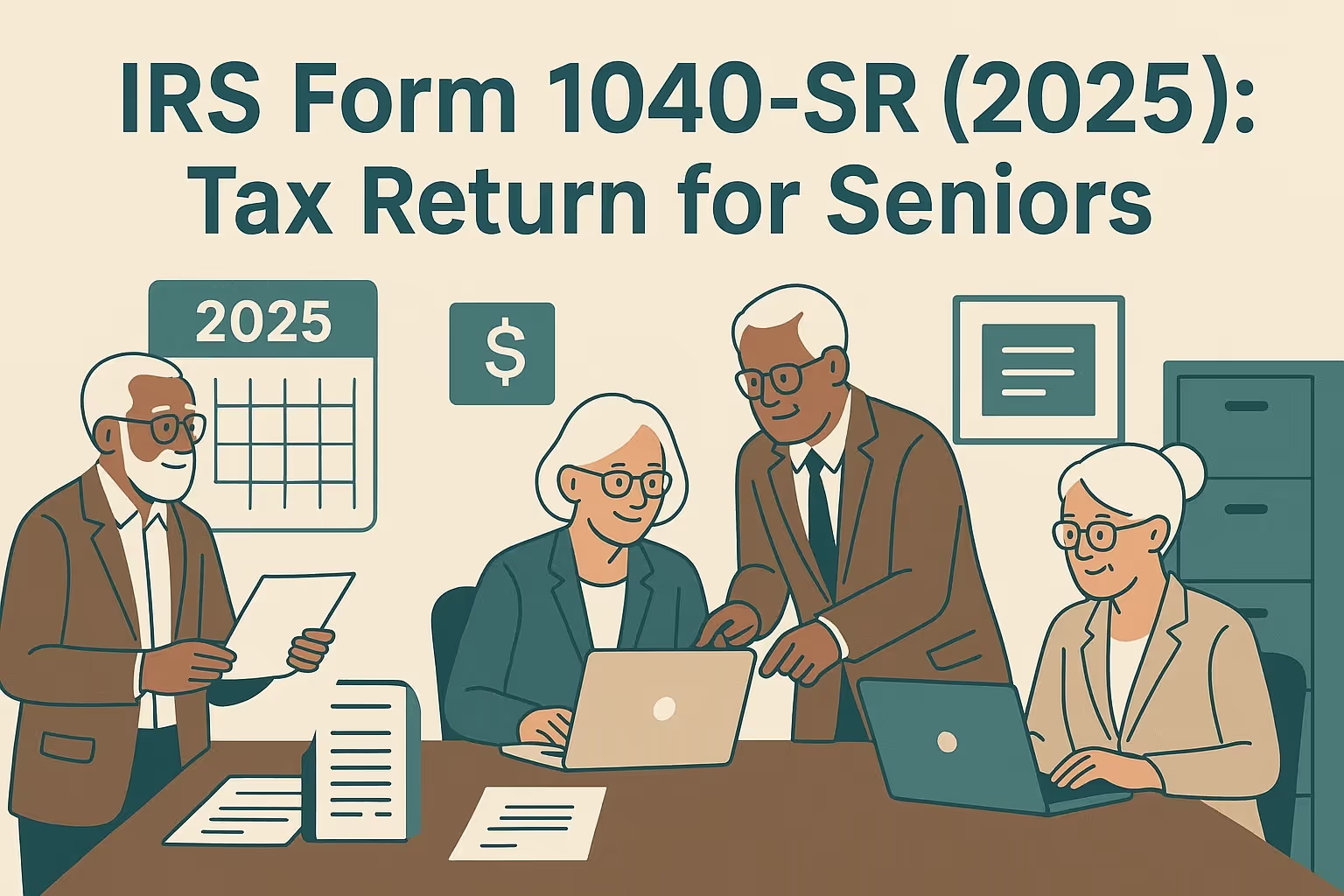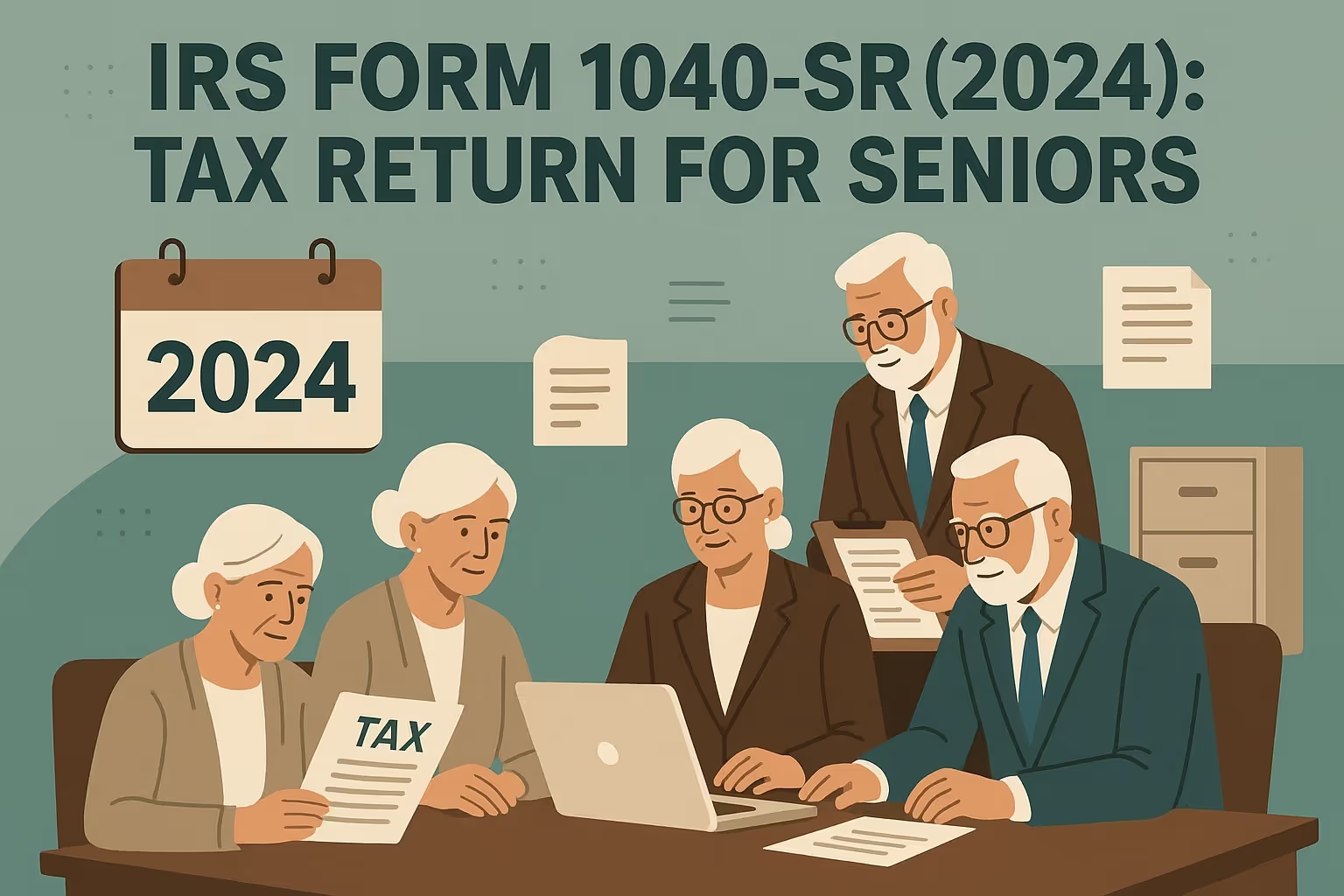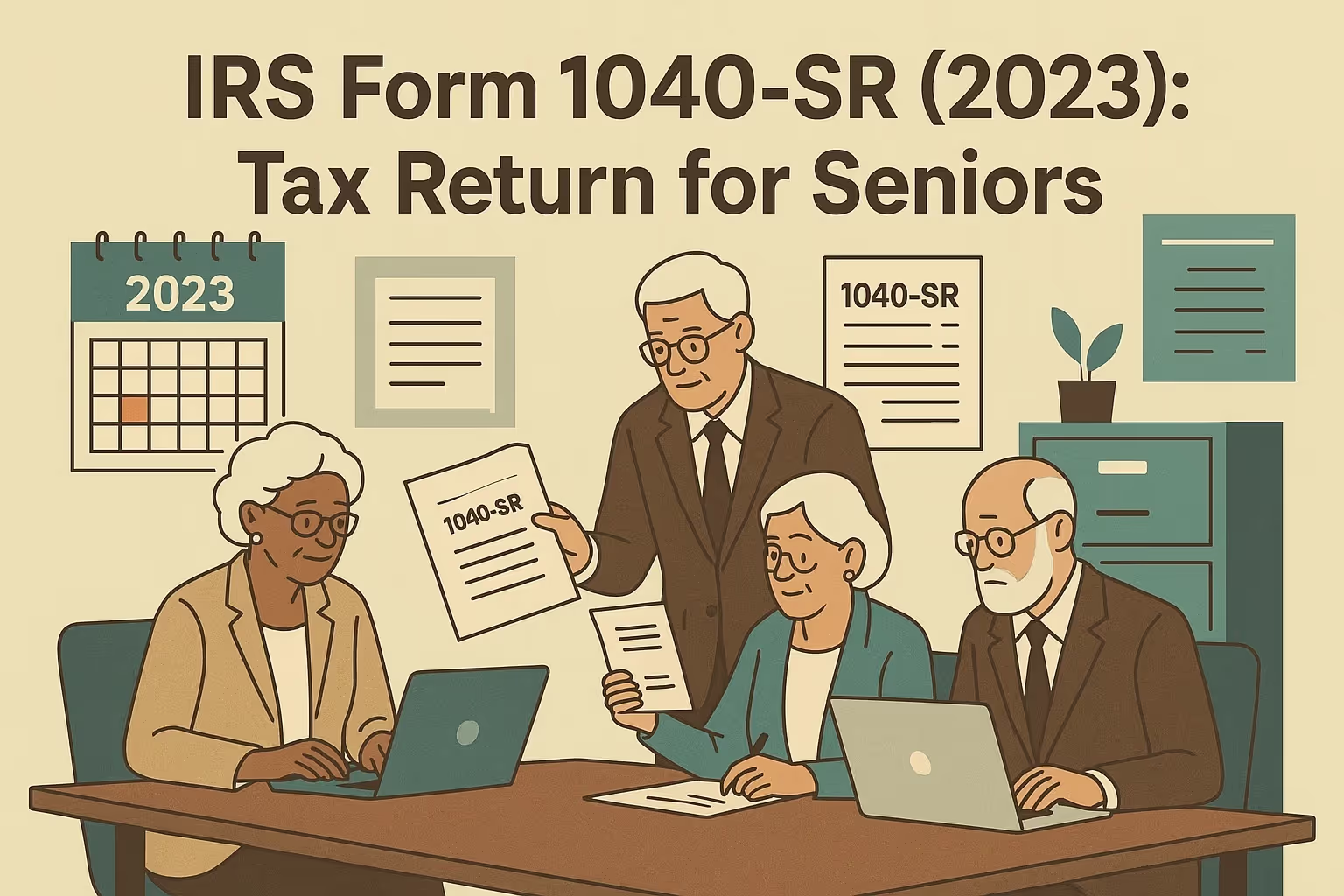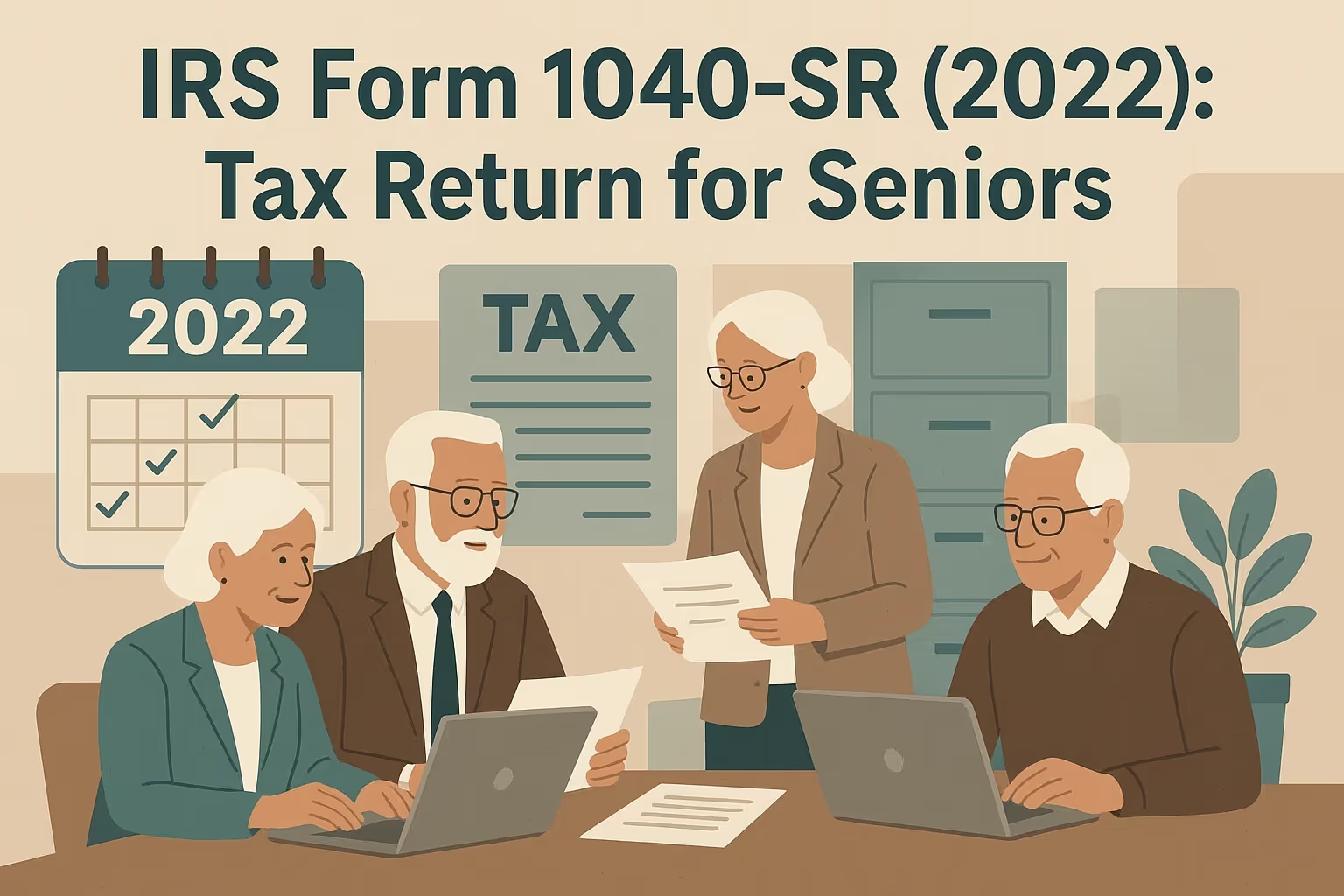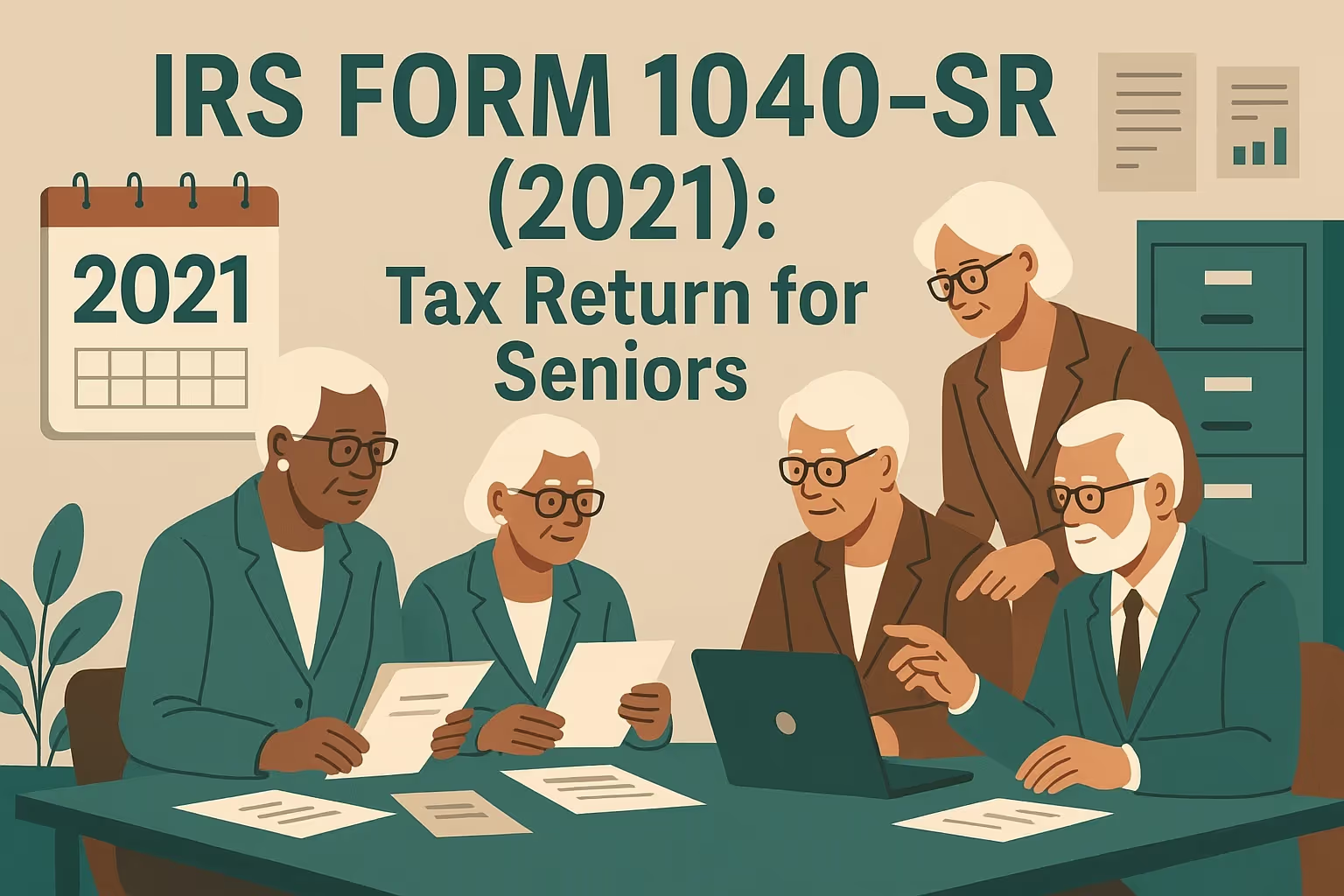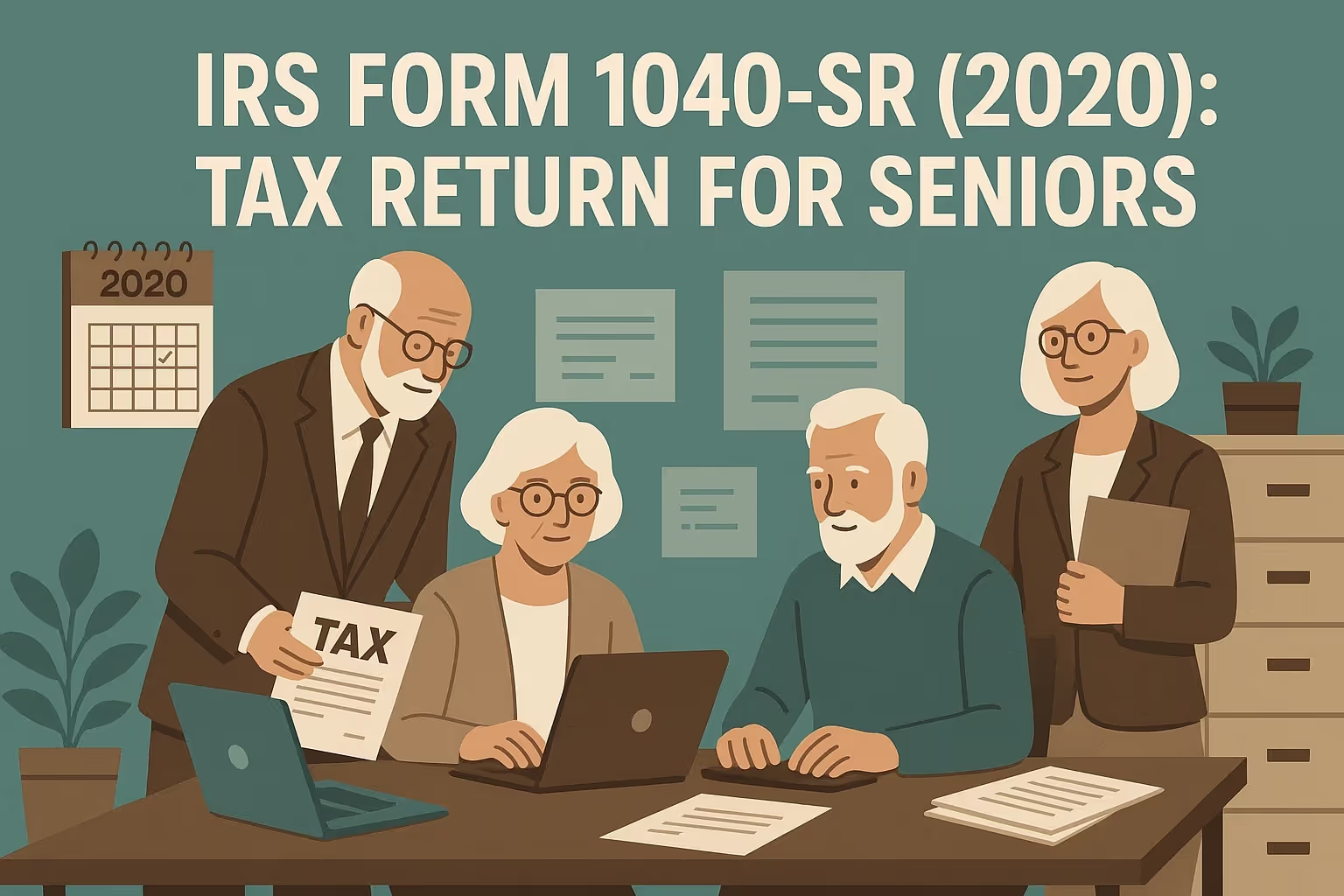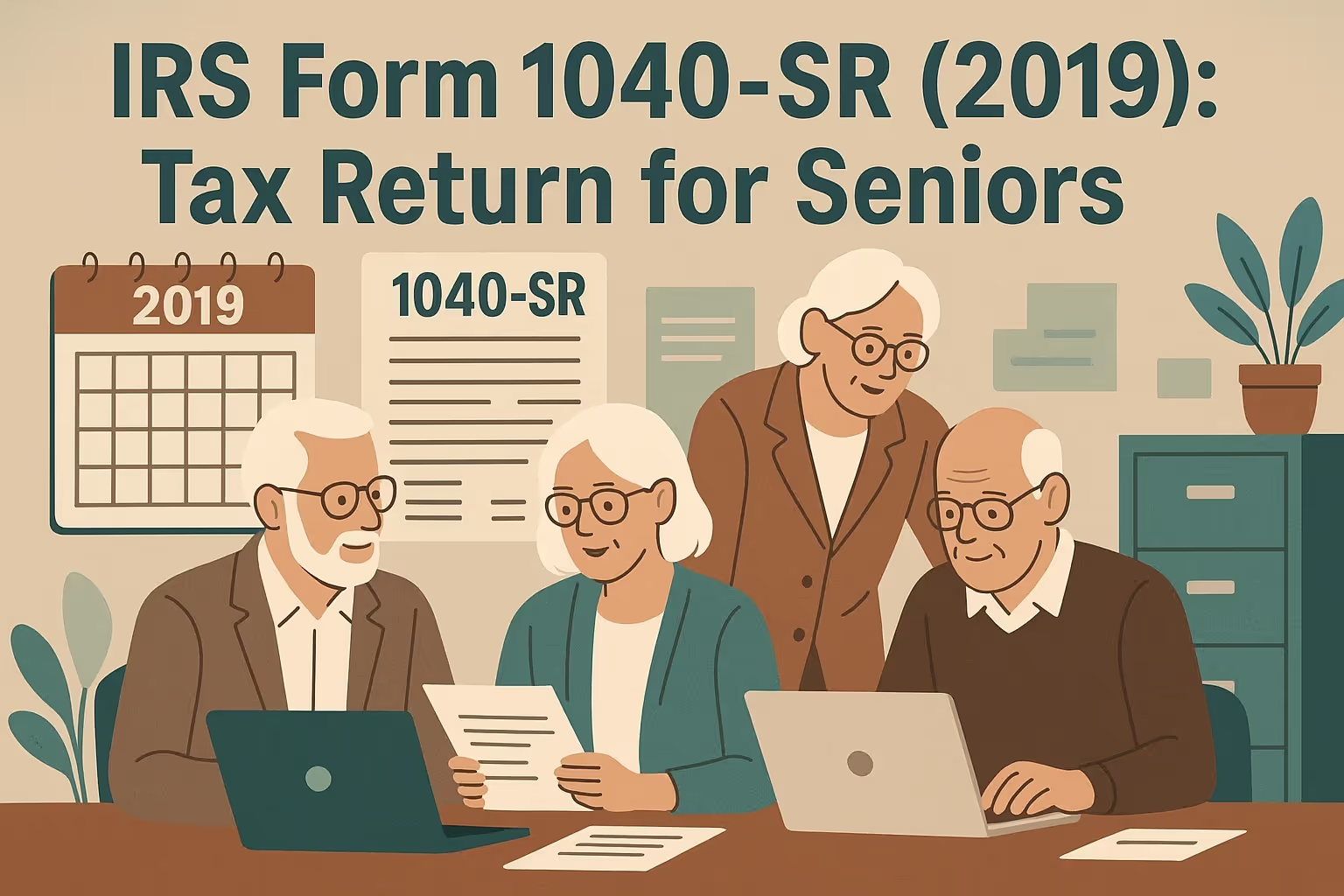Form 1040SR 2018 Instructions: Complete Guide for Seniors

Filing an individual income tax return for the 2018 tax year required all taxpayers, including older adults, to adjust to significant changes. The Internal Revenue Service (IRS) introduced a redesigned IRS tax form that replaced previous federal tax forms and simplified tax filing. Seniors had to use the standard Form 1040 because the easier-to-read version, Form 1040SR, was not yet available.
The new filing process reflected major provisions of the Bipartisan Budget Act, affecting deductions, credits, and filing status rules. Understanding taxable income, tax deductions, and available tax credits, such as the child tax credit or foreign tax credit, was essential. Seniors also had to consider Social Security benefits, retirement income, unemployment compensation, and additional income like rental income or self-employment. Choosing between standard deduction amounts and the option to itemize deductions became critical.
This guide explains how to complete the 2018 federal income tax return step by step. It covers IRS forms, schedules, estimated tax payments, additional taxes, and education credits. Seniors will also learn about tax liability, estimated tax penalty rules, payment voucher requirements, and household employment taxes. With clear guidance, taxpayers can prepare paper returns or file jointly or married filing separately accurately, maximize refunds, and comply with the federal tax code.
Overview of Form 1040
The 2018 tax year marked a transition for taxpayers. Seniors had to understand the redesigned federal tax return and how the same schedules applied to all filers. This change replaced prior simplified forms and required everyone to work with the single Form 1040 structure.
Purpose of the 2018 Federal Tax Return
- Single form system: The IRS eliminated prior versions to create a single return supported by numbered schedules for different tax situations.
- Consistency: Seniors had to follow the same schedules as other taxpayers, which standardized the process but required more careful review of instructions.
- Focus on compliance: The new approach aimed to simplify filing and emphasized accuracy in reporting income, deductions, and credits.
Who Needed to File Taxes in 2018
- Seniors with taxable income: Anyone above the income threshold had to file taxes, even if most income came from Social Security or pensions.
- Retirees with investment income: Interest, dividends, and capital gains meant seniors were required to submit a complete return.
- Individuals owing self-employment tax: Seniors with side businesses or freelance work had to report income and pay self-employment tax as part of the filing.
What Is New for 2018 Tax Filing
Seniors preparing their taxes in 2018 faced new rules that changed credits and deductions. The IRS updated tax brackets, removed exemptions, and increased standard deduction amounts, influencing how taxpayers completed the federal tax return.
Standard Deduction Chart for Seniors
- Increased base amounts: The standard deduction rose to $12,000 for singles and $24,000 for married couples filing jointly.
- Age-based addition: Seniors 65 and older received an extra deduction, raising their filing threshold and often reducing their tax liability.
- Impact on itemizing: With higher amounts available, many seniors stopped itemizing deductions for mortgage interest or charitable donations.
Suspension of Personal Exemptions
- Eliminated exemptions: The deduction of $4,050 per person was suspended starting in 2018.
- Effect on families: This shift increased reliance on credits like the child tax credit or the credit for other dependents.
- Adjustment needed: Seniors supporting dependents had to review credits instead of exemptions to reduce their income tax.
Changes to Federal Tax Brackets
- Lower rates: The IRS reduced most federal tax rates in 2018, easing the burden for many seniors and working taxpayers.
- Wider ranges: Expanded income brackets allowed more individuals to remain in lower tax brackets, directly reducing the amount they had to pay.
- Relevance for retirees: Seniors with investment income saw potential savings depending on their taxable income levels.
Expanded Child and Dependent Credits
- Child tax credit increase: The amount doubled to $2,000 per qualifying child, offering families a meaningful income tax credit.
- Other dependent credit: A new $500 credit applied to dependents not covered under the child tax credit.
- Senior households: Those supporting older relatives or adult children could claim this general credit and reduce tax owed.
New Limit on SALT Deductions
- Maximum allowed: State and local tax deductions were limited to $10,000, impacting taxpayers in higher-tax states.
- Effect on itemizing: Seniors with property in a state with a state income tax had to adjust their itemizing strategy.
- Simplification option: Many shifted to the standard deduction because of these new restrictions.
Step-by-Step Instructions for Preparing Your 2018 Return
Preparing taxes requires accuracy and planning. Seniors filing a federal tax return in 2018 had to follow a structured process. Each step below outlines what must be completed to ensure compliance and reduce errors when submitting forms.
Step 1: Gather Required Federal Tax Forms
Collect all forms and statements before you start preparing your return. Seniors needed Social Security statements, pension forms, investment income reports, and prior tax returns. Accurate documentation provided the foundation for reporting income, deductions, and credits while ensuring nothing was missed during the filing process.
Step 2: Enter Personal Information
Provide your name, address, and Social Security number exactly as recorded by official agencies. Seniors had to confirm this information carefully to avoid errors that could delay processing. Filing status had to be selected based on current age, marital situation, and dependency considerations to ensure the correct calculation of deductions and credits.
Step 3: Report Dependents
List qualifying children or other dependents, including their Social Security numbers and relationship to you. Seniors often claimed dependents when supporting family members. Correctly reporting this section ensures access to valuable credits, such as the child tax credit or the credit for other dependents.
Step 4: Report Income
Include wages, pensions, annuities, investment income, and Social Security benefits. Each type of income had a specific line and required accuracy. Seniors with multiple income sources had to review all forms carefully to ensure proper reporting. Self-employment also applies if a business or freelancer receives income during the 2018 tax year.
Step 5: Itemize Deductions or Apply Standard Deductions
Use the standard deduction chart or itemize deductions such as mortgage interest, charitable donations, and medical expenses. Seniors had to compare totals to maximize their benefit. Many found that the increased standard deduction simplified the process and reduced the need for itemizing. Selecting the right method helped lower overall federal tax liability.
Step 6: Calculate Federal Tax
Follow IRS instructions to calculate total federal tax owed. The process involved using tax tables, considering credits, and applying adjustments. Taxpayers could claim income tax credit programs like the child and general business credits to reduce taxes owed. Accuracy here ensured seniors did not pay more than required for their tax situation.
Step 7: Claim Credits
Apply credits that fit your eligibility. Seniors could claim the child tax credit, the credit for other dependents, or the credit for the elderly and disabled. The general business credit applied if they had qualifying activities. Properly using these options could increase the refund or reduce the amount they owe on the federal tax return.
Step 8: Review and Sign
Verify accuracy before signing the return. Seniors had to double-check Social Security numbers, schedules, and totals. Tax experts recommend reviewing every line to avoid common errors. If filing jointly, both spouses had to sign the return. Signing confirms that the taxpayer's return was complete, accurate, and acknowledged according to IRS requirements.
Filing Your Individual Income Tax Return
In 2018, seniors had to choose between electronic filing and paper filing. Both methods were available, and the decision depended on personal preference, access to technology, and comfort with using tax software or traditional forms. Selecting the correct filing approach ensured timely processing and reduced the risk of missed deadlines.
Electronic Filing
- Faster refunds: Filing electronically allowed seniors to receive their refunds in weeks, ensuring quicker refund access than longer paper-based processing times.
- Maximum refund guaranteed: Many tax software providers offer a maximum refund guaranteed feature, promising accuracy checks to help taxpayers maximize available deductions and credits.
- Free access: Seniors with qualifying income could use the IRS website to access free filing software, which provides guidance and ensures their returns are prepared accurately.
Paper Filing
- Traditional process: Seniors who preferred manual filing could complete and mail paper forms, ensuring they followed the official process while retaining physical copies.
- Supporting documents: Paper filers were required to attach forms such as W-2s, 1099s, and schedules, ensuring their return reflected all income and deductions accurately.
- Longer timeline: Seniors filing on paper often experienced refund delays, as mailed forms required manual IRS processing and longer waiting times before receiving refunds.
Extensions for Seniors
- Automatic extension: Seniors could file Form 4868 to automatically extend their federal tax return filing deadline to October, allowing extra time for preparation.
- Payment requirement: Even with an extension, seniors were still required to pay any taxes owed by the April deadline to avoid penalties.
- Process clarity: Filing extensions required accuracy and timeliness, as incorrect submissions or late requests could result in penalties or processing complications with the IRS.
Payment Instructions for Federal Tax Return
In 2018, seniors who owed federal tax had several payments. The IRS encouraged taxpayers to use secure electronic payment systems, though traditional paper-based payments remained available. Understanding the process prevented missed deadlines and ensured payments were applied accurately to the correct return year.
Payment Methods
- IRS Direct Pay: This free service allows taxpayers to securely transfer money directly from their bank accounts, ensuring accurate posting and eliminating unnecessary processing fees.
- Electronic Federal Tax Payment System: This government system was commonly used by employers, but individuals filing their taxes could also use it for secure, scheduled federal payments.
- Cards and checks: Seniors could use credit or debit cards with third-party processing fees, or mail checks with Form 1040-V for proper payment documentation.
Payment Plans
- Short-term arrangements: Seniors who could not pay in full could request a short-term plan, allowing up to 120 days for payment without added setup fees.
- Installment agreements: Longer payment solutions required setup fees and involved monthly installments, with continued interest until balances were completely paid to the IRS.
- Expert help is recommended: Tax experts often advise seniors to explore installment agreements, ensuring payments match their income levels and ability to pay federal taxes.
Required Schedules and Attachments
The redesigned tax filing process f018 included six numbered schedules that applied to specific tax situations. Seniors must understand which schedules appear on their return and attach them when necessary. Using the correct schedules helps maintain accuracy and prevent delays in processing or errors in refund calculation.
Numbered Schedules (1–6)
- Schedule 1: Seniors used this schedule to report additional income, such as self-employment or unemployment income, and adjustments reducing taxable amounts.
- Schedule 2: This applies when calculating additional taxes, including alternative minimum tax or taxes on retirement plans, ensuring compliance with federal requirements.
- Schedule 3: Taxpayers used this to claim the general business or child tax credit, reducing their final federal tax liability.
- Schedule 4: Seniors filed this for additional federal taxes, including self-employment or unreported Social Security and Medicare taxes owed.
- Schedule 5: This allowed reporting of estimated payments already made and extension-related credits, ensuring taxpayers received proper acknowledgment from the IRS.
- Schedule 6: Complete this schedule for seniors with a foreign address or who have designated a third party to discuss their return with the IRS.
Traditional Schedules
- Schedule A: This schedule is used to itemize deductions, including mortgage interest, charitable donations, and state and local taxes, subject to the $10,000 SALT cap.
- Schedule B: This schedule reports interest and dividend income from investments and ensures that seniors properly disclose earnings above the minimum reporting thresholds.
- Schedule D: This schedule is applied to capital gains or losses, particularly for seniors with investment income from stocks, bonds, or real estate sales that require official reporting.
- Schedule R: This schedule is designed for the elderly or disabled. It allows qualifying seniors to reduce the tax owed if their income is under certain thresholds.
Common Mistakes to Avoid in Your Tax Filing
Even with expert help or tax software, errors occurred frequently in 2018. Seniors filing their taxes had to review forms, credits, and schedules carefully. Recognizing the most common mistakes prevented delays, reduced the chance of missed refunds, and ensured every taxpayer achieved accuracy and compliance with IRS expectations.
Social Security and Personal Information Errors
- Incorrect numbers: Entering the wrong Social Security numbers caused delays and required IRS contact for correction. Seniors needed to double-check every digit carefully.
- Name mismatches: Differences between Social Security records and tax forms delayed processing, so updating personal information with agencies before filing was critical.
- Missing signatures: Unsigned paper returns were considered incomplete, and the IRS returned them, delaying refunds and extending the entire process unnecessarily.
Deduction and Credit Miscalculations
- Standard deduction errors: Some seniors forgot to include the additional standard deduction for age, reducing their refund or causing higher tax owed.
- Child tax credit mistakes: Seniors missed money they could have legally received by incorrectly listing dependents or failing to claim eligible credits.
- Charitable donations: Seniors sometimes failed to keep receipts or documentation, which meant losing deductions or being unable to substantiate claims during audits.
Income Reporting Mistakes
- Investment income issues: Many seniors missed reporting dividends or capital gains, which increased errors and triggered IRS notices requiring additional review.
- Retirement distributions: Required minimum distributions had to be reported, and failing to do so created penalties, errors, and additional taxes owed unnecessarily.
- Self-employment: Seniors who do freelance work sometimes overlook their self-employment income, resulting in unpaid federal taxes and inaccurate filings.
Zero Activity or Dormant Year Guidance
Some seniors did not have to file a return in 2018. Filing thresholds increased due to the higher standard deduction chart, meaning some with limited income avoided filing. Still, many seniors file taxes voluntarily to claim refunds or establish a record with the IRS for future years.
When Filing Was Not Required
- Low income: Seniors with Social Security as their only income were often under the filing threshold and not required to submit a tax return.
- Dormant year: As long as they have neither investment income nor wages, retirees may be exempt from IRS filing requirements for a year.
- High deduction amounts: When deductions exceeded income, the filing requirement no longer applied, relieving seniors from submitting returns.
Why Filing Might Still Be Smart
- Refund eligibility: Seniors could still qualify for a refund if federal taxes were withheld, even if their income was below the required filing levels.
- Claiming credits: Filing allowed seniors to claim refundable credits, such as income or child tax credits, ensuring they did not miss valuable benefits.
- Identity protection: Filing each year establishes a record, preventing fraudulent returns from being filed in their names and protecting against tax identity theft.
First-Time Filer Tips for Seniors
Some seniors filed taxes for the first time in 2018 due to changes in income or life circumstances. Clear guidance was important to avoid confusion and complete each step properly. Organization, preparation, and professional support options simplified the first-time experience and improved accuracy for new filers.
Getting Organized
- Essential documents: Seniors needed Social Security cards, prior tax returns, bank details, and official forms like W-2s, 1099s, or pension statements.
- Expense records: Maintaining receipts for medical costs, charitable donations, or mortgage interest ensured accurate reporting when itemizing instead of using the standard deduction.
- Organized system: Filing was easier when seniors grouped paperwork by category, making it simpler to enter accurate amounts and complete the process without errors.
Choosing Support Options
- Free IRS programs: VITA and TCE provide services with tax experts trained to assist seniors, offering expert help for complex tax situations.
- AARP Tax-Aide: This program is available to all seniors. It provides access to trained volunteers who offer free preparation services and answer tax questions in detail.
- Professional preparers: Certified preparers with experience handling federal tax returns for seniors offered guaranteed accuracy, ensuring complex situations were managed responsibly.
Filing Tips for Accuracy
- Start early: Seniors benefited from beginning tax preparation in January, giving them more time to find solutions if problems or missing forms arose.
- Review thoroughly: Carefully checking calculations, credits, and schedules avoided mistakes that could delay refunds or result in unnecessary money owed to the IRS.
- Use software carefully: Tax software with built-in accuracy features helped seniors maximize deductions and ensured they received the maximum refund guaranteed when filing.
Frequently Asked Questions
Do I need to file a tax return if Social Security was my only income in 2018?
You may not need to file a tax return if Social Security was your only income and it fell below the filing threshold. However, filing may still be beneficial if federal taxes were withheld from benefits or if you wish to claim refundable credits. Filing also protects against fraudulent use of your information.
What was my standard deduction as a senior for the 2018 tax year?
The standard deduction for 2018 was $12,000 for single filers, $24,000 for married filing jointly, and $18,000 for heads of household. Seniors age 65 or older received additional amounts, increasing their deduction. Choosing between the standard deduction chart and itemizing allowed taxpayers to maximize benefits while improving their federal tax return accuracy.
Can seniors claim the child tax credit or other dependent credits?
Yes, seniors could claim the child tax credit if they had qualifying children under age 17. A separate credit for other dependents worth $500 was also available. Seniors supporting adult children or elderly relatives could apply this to their federal tax return, reducing federal tax owed and helping maximize their refund in 2018.
What options were available for seniors unable to pay their federal tax balance?
Seniors unable to pay their full balance could apply for short-term payment plans or long-term installment agreements with the IRS. Each option included interest and possible setup fees, but both allowed manageable monthly payments. Seeking experts' help to ensure seniors select the right plan and avoid penalties while complying with federal tax requirements.
How did tax software benefit seniors filing their returns in 2018?
Tax software provided seniors with guidance, error checks, and built-in features ensuring accuracy. Many programs offered maximum refund guaranteed promises, step-by-step instructions, and easy access through any device. Seniors with simple tax situations could file for free, while those with complex cases could benefit from expert help integrated within the software.
What common errors should seniors avoid when preparing their 2018 federal tax return?
Common errors included entering incorrect Social Security numbers, failing to sign paper returns, and misreporting retirement distributions or investment income. Seniors also overlooked the additional age deduction or could not claim available credits. Careful review, use of tax software, or consulting tax experts ensured accuracy, prevented delays, and safeguarded access to refunds or credits.





